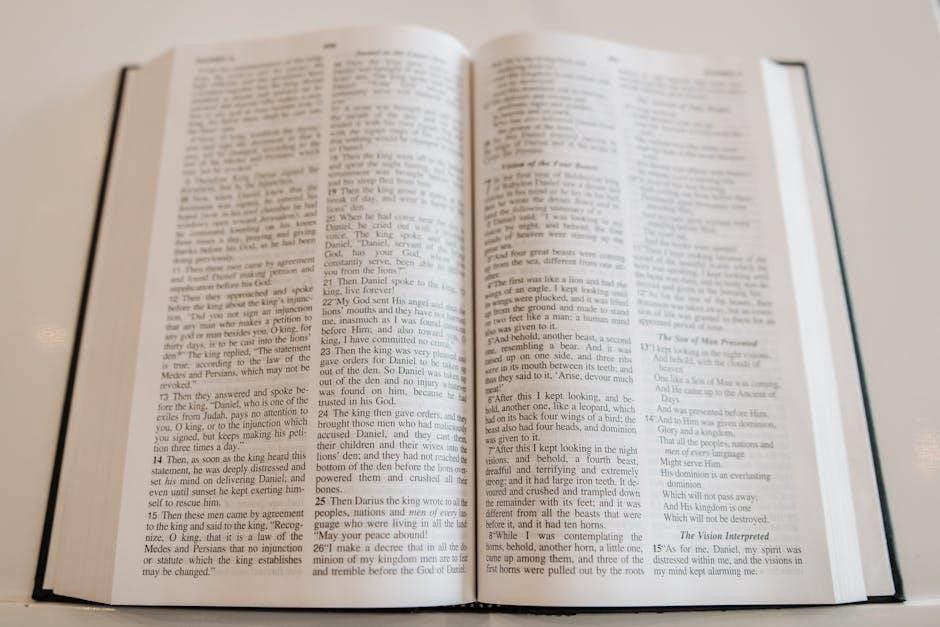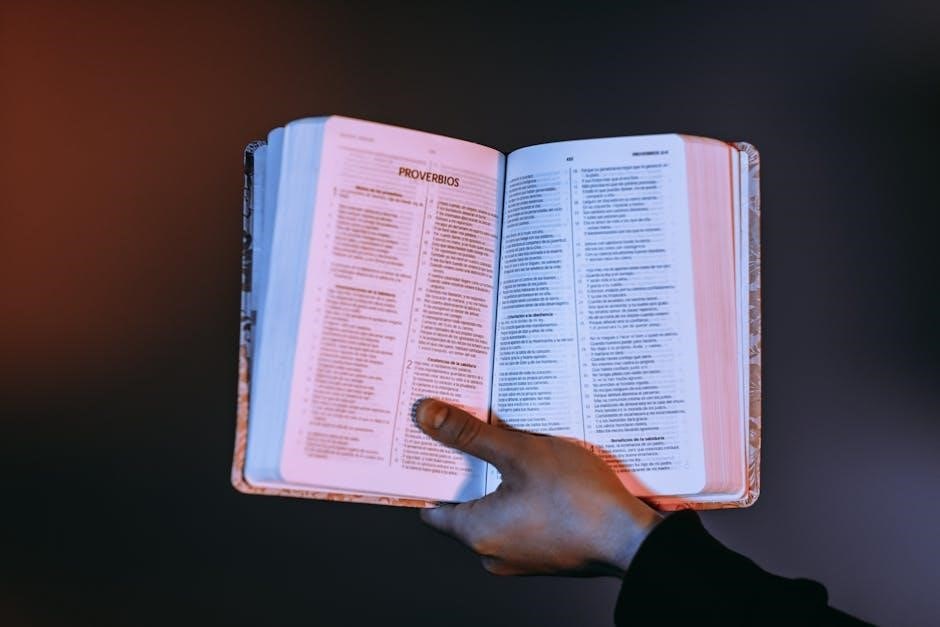
barnabas gospel pdf
The Barnabas Gospel is an ancient text challenging traditional Christian views, claiming Judas Iscariot was crucified in Jesus’ place and predicting Muhammad’s arrival, sparking theological debates globally.
1.1 Definition and Overview
The Barnabas Gospel is an ancient religious text that challenges traditional Christian beliefs by suggesting that Judas Iscariot was crucified in Jesus’ place and that Jesus predicted the coming of Muhammad. This text, which exists in a leather-bound form discovered in Turkey in 2000, has sparked significant theological debates. Its content contradicts key Christian doctrines, leading to its dismissal by some religious leaders. The availability of a PDF version has facilitated its dissemination, contributing to ongoing discussions about its authenticity and implications.
1.2 Historical Significance
The Barnabas Gospel holds profound historical significance as an ancient text that challenges traditional Christian narratives. Discovered in Turkey in 2000, its leather-bound manuscript is believed to date back centuries, offering a unique perspective on early Christian history. The text’s claims about Judas Iscariot and the prediction of Muhammad have sparked intense debate, potentially reshaping understanding of religious history. Its availability in PDF form has further amplified its impact, making it a focal point in modern interfaith discussions and historical scholarship.
1.3 Purpose of the Gospel
The Barnabas Gospel aims to present an alternative narrative to the traditional Christian account, challenging key beliefs. It claims Judas Iscariot was crucified in Jesus’ place and predicts Muhammad’s arrival, aligning with Islamic theology. The text seeks to provide a differing perspective on Jesus’ life and legacy, potentially influencing interfaith dialogue. Its controversial claims have sparked debates, with some viewing it as a tool to bridge religious gaps, while others dismiss it as heretical, highlighting its divisive yet thought-provoking purpose in religious discourse.

The Discovery of the Barnabas Gospel
The Barnabas Gospel was discovered in 2000 in Turkey, seized by authorities during an antiquities smuggling crackdown, sparking global interest in its historical and theological significance.
2.1 The 2000 Discovery in Turkey
The Barnabas Gospel was discovered in 2000 in Turkey during a crackdown on antiquities smuggling. Turkish authorities seized the text, sparking global interest in its historical significance. The leather-bound document, written in an ancient style, was initially met with skepticism but later gained attention for its unique theological claims. Its discovery has been a focal point in debates about early Christian history and its potential implications for religious doctrines. The text’s authenticity remains a subject of scholarly investigation and public curiosity.
2.2 The Role of Turkish Authorities
Turkish authorities played a pivotal role in the discovery of the Barnabas Gospel, seizing it in 2000 during an operation against antiquities smugglers. Recognizing its potential historical significance, they took measures to preserve the text and facilitate scholarly examination. However, initial assessments raised questions about its authenticity, leading to further investigation. The Turkish government’s actions brought the document to light, sparking global interest and debate, while also highlighting the challenges of verifying ancient texts in the modern era.
2.3 Initial Reactions to the Discovery
The discovery of the Barnabas Gospel in 2000 sparked mixed reactions. Scholars expressed excitement over its potential to reshape biblical understanding, while religious leaders remained cautious. The text’s claims, such as Judas Iscariot’s crucifixion and references to Muhammad, fueled immediate debate. Some viewed it as a forgery, while others saw it as a lost treasure. The Coptic Patriarch dismissed its significance, calling it worthless. These contrasting responses highlighted the text’s controversial nature and set the stage for ongoing theological and historical discussions.

Theological Implications
The Barnabas Gospel contradicts the New Testament, claiming Judas Iscariot was crucified in Jesus’ place and predicting Muhammad’s arrival, challenging core Christian doctrines and sparking debates.
3.1 Contradictions with the New Testament
The Barnabas Gospel contradicts the New Testament by claiming Judas Iscariot was crucified in Jesus’ place, not Jesus himself. It also predicts Muhammad’s arrival, absent in Christian texts. These narratives challenge the foundational belief in Jesus’ resurrection and divine mission, creating theological tension. The Gospel’s account undermines the New Testament’s portrayal of Jesus’ crucifixion and its significance, leading to debates about its authenticity and implications for Christian doctrine;
3.2 The Claim of Judas Iscariot’s Crucifixion
The Barnabas Gospel shockingly claims that Judas Iscariot was crucified in Jesus’ place, while Jesus ascended to heaven unharmed. This directly contradicts the New Testament’s account of Jesus’ crucifixion and resurrection. The text describes Judas as a victim of divine deception, challenging the Christian belief in Jesus’ sacrificial death. Religious leaders, including Coptic Patriarch Tawadros II, have dismissed this narrative as baseless, emphasizing its incompatibility with established Christian doctrine and historical records.
3.3 The Prediction of Muhammad in the Gospel
The Barnabas Gospel controversially includes a prophecy where Jesus foretells the coming of Muhammad, describing him as the “Messenger of God.” This passage has sparked intense debate, with some interpreting it as evidence of Muhammad’s divine appointment. However, Christian leaders, including Coptic Patriarch Tawadros II, have rejected this claim, labeling the text as fraudulent and inconsistent with biblical teachings. The prophecy has become a focal point in interfaith discussions, highlighting tensions between Christian and Islamic interpretations of scripture.
3.4 Challenges to Christian Doctrine
The Barnabas Gospel challenges core Christian beliefs by suggesting Judas Iscariot was crucified in Jesus’ place, contradicting the New Testament’s account of Jesus’ resurrection. It also predicts Muhammad’s arrival, which some interpret as validating Islamic theology. These claims undermine the foundational Christian doctrine of Jesus as the Messiah and son of God. The text’s assertions have sparked heated debates, with Christian leaders dismissing it as fraudulent and inconsistent with biblical teachings, while others view it as a bridge between Christian and Islamic traditions.

Controversies Surrounding the Text
The Barnabas Gospel sparks intense debate, with the Coptic Patriarch dismissing it as worthless, while Iranian media claims it could collapse Christianity, challenging core doctrines.
4;1 Debates Over Authenticity
The authenticity of the Barnabas Gospel is highly contested, with scholars debating its origins and validity. The Coptic Patriarch has dismissed it as worthless, while others argue it challenges Christian doctrine. Discovered in Turkey in 2000, its historical value is questioned, with some claiming it is a forgery. The text’s prediction of Muhammad and alternative crucifixion narrative fuel debates about its legitimacy and relevance to religious history. Its impact on interfaith relations and theological discussions remains a contentious issue.
4.2 The Impact on Christian and Islamic Relations
The Barnabas Gospel has sparked significant tension between Christian and Islamic communities. Its prediction of Muhammad and alternative crucifixion narrative have been seized upon by some Islamic scholars to validate Islamic theology, while Christians dismiss it as heretical. The text’s dissemination online has fueled interfaith debates, with some viewing it as a bridge between religions and others as a divisive tool. Its discovery in Turkey and subsequent discussions have heightened religious sensitivities, making it a focal point in interfaith dialogue and conflict.
4.3 Reactions from Religious Leaders
Coptic Patriarch Tawadros II dismissed the Barnabas Gospel as worthless, while Iranian media claimed it could collapse Christianity. Christian leaders have rejected its authenticity, calling such claims laughable. Islamic scholars, however, view it as validating Islamic theology, particularly its prediction of Muhammad. The text has polarized religious leaders, with some embracing it as a bridge for interfaith dialogue and others condemning it as heresy. These divergent reactions highlight the gospel’s controversial nature and its impact on religious discourse globally.
4.4 The Role of the Coptic Patriarch
Coptic Patriarch Tawadros II has played a significant role in addressing the Barnabas Gospel, dismissing it as worthless and rejecting its authenticity. His stance underscores the Coptic Church’s commitment to traditional Christian doctrine. By labeling the text as insignificant, Tawadros II aims to mitigate its potential impact on Christian communities. His authority influences many followers, reinforcing the Church’s position against the gospel’s controversial claims. This highlights the patriarch’s role in safeguarding orthodox beliefs amid theological challenges posed by such texts.

The Gospel of Barnabas and Its PDF Version
The Barnabas Gospel’s PDF version has become widely accessible online, fueling debates and discussions about its controversial claims and theological implications, reaching a global audience digitally.
5.1 Availability and Accessibility Online
The Barnabas Gospel PDF is widely available online, with numerous digital platforms hosting the text. Its accessibility has led to increased visibility and debate, particularly among religious scholars and enthusiasts. The PDF format allows easy sharing and downloading, making it a focal point for discussions about its theological implications. Digital archives and websites have played a significant role in disseminating the text globally, ensuring its reach extends beyond traditional academic circles to a broader audience interested in its controversial claims.
5.2 The Role of Digital Platforms in Dissemination
Digital platforms have significantly facilitated the spread of the Barnabas Gospel PDF, enabling global access to its controversial content. Websites, social media, and eBook repositories host the text, making it easily downloadable. This digital availability has sparked widespread discussion, particularly among religious communities. The ease of sharing and accessing the PDF has amplified its influence, contributing to ongoing debates about its theological implications and historical authenticity. Digital dissemination has thus played a pivotal role in shaping modern perceptions of the Barnabas Gospel.
5.3 The Influence of the PDF on Modern Debates
The Barnabas Gospel PDF has become a focal point in modern religious debates, particularly regarding its theological claims. Its digital availability has enabled widespread dissemination, fostering discussions across religious communities. The text’s assertion of Judas Iscariot’s crucifixion and the prediction of Muhammad has sparked intense dialogue, challenging traditional Christian narratives. While some view it as a credible alternative, others dismiss it as heretical. The PDF’s accessibility has amplified its impact, making it a key resource in interfaith discussions and debates about religious history and doctrine.

Historical and Cultural Significance
The Barnabas Gospel bridges Christian and Islamic traditions, offering unique insights into interfaith dialogue and influencing literature, art, and theological discussions across cultures historically.
6.1 The Gospel in Islamic Tradition
The Barnabas Gospel holds significance in Islamic tradition, as it aligns with Islamic beliefs about Jesus and prophesies the coming of Muhammad. Muslims view it as a validation of their faith, supporting the Islamic narrative of Jesus’ life and mission. This text is often cited in interfaith discussions, offering a bridge between Christian and Islamic perspectives. Its discovery has sparked interest among scholars and believers alike, fostering dialogue and debate about its role in religious history and doctrine.

6.2 The Gospel’s Role in Interfaith Dialogue
The Barnabas Gospel serves as a bridge in interfaith dialogue, offering insights that resonate with both Christian and Islamic traditions. Its narrative, particularly the prediction of Muhammad, has sparked discussions about shared theological roots. While some view it as a tool for fostering mutual understanding, others see it as a source of tension. Religious leaders and scholars often reference the text in debates, highlighting its potential to challenge or reinforce existing beliefs. This dialogue continues to shape modern religious discourse and interfaith relations globally.
6.3 The Gospel’s Influence on Literature and Art
The Barnabas Gospel has inspired numerous literary and artistic works, sparking curiosity and debate. Its unique narrative has influenced novels, films, and academic studies, exploring its theological themes. Artists have depicted scenes from the text, while writers have woven its stories into contemporary narratives. This cultural impact reflects its ability to transcend religious boundaries, fostering dialogue and creativity across diverse audiences. Its influence continues to grow, making it a significant subject in both religious and secular contexts.

Comparisons with the New Testament
The Barnabas Gospel contradicts the New Testament by claiming Judas Iscariot was crucified instead of Jesus and predicting Muhammad’s arrival, challenging traditional Christian beliefs and narratives.
7.1 Narrative Differences
The Barnabas Gospel diverges significantly from the New Testament, asserting Judas Iscariot was crucified in Jesus’ place and predicting Muhammad’s arrival. It challenges the crucifixion narrative, suggesting Jesus ascended to heaven unharmed. This contradicts the New Testament’s depiction of Jesus’ death and resurrection, central to Christian theology. The text also omits key events like the Last Supper and the Virgin Birth, offering a distinct perspective on Jesus’ life and mission. These differences spark intense theological and scholarly debates about its authenticity and implications for Christian doctrine.
7.2 Theological Contrasts
The Barnabas Gospel presents stark theological contrasts, denying Jesus’ crucifixion and resurrection, core Christian doctrines. It claims Judas Iscariot was crucified in Jesus’ place, with Jesus ascending to heaven unharmed. This directly opposes the New Testament’s depiction of Jesus’ sacrificial death and resurrection. Additionally, the text predicts Muhammad’s arrival, aligning with Islamic theology. These contrasts challenge the divinity of Jesus and the concept of atonement, creating significant theological tensions between Christian and Islamic interpretations of Jesus’ mission and legacy.
7.3 Implications for Biblical Scholarship

The Barnabas Gospel challenges the accuracy of the New Testament, prompting scholars to reevaluate early Christian texts. Its claims contradict traditional narratives, sparking debates about the Bible’s historical context. The text’s existence raises questions about the formation of the biblical canon and the exclusion of alternative accounts. Scholars are compelled to explore its origins and authenticity, potentially reshaping understanding of early Christianity. This discovery fuels academic inquiry into the diversity of early Christian thought and the validation of non-canonical texts.

The Gospel of Barnabas in Modern Context
The Barnabas Gospel’s digital availability fuels contemporary debates, challenging traditional beliefs and sparking discussions on its relevance in the digital age and its impact on public perception.
8.1 The Gospel’s Relevance in the Digital Age
The Barnabas Gospel’s PDF version has heightened its relevance in the digital age, enabling widespread dissemination through online platforms. Social media and digital archives have made the text accessible globally, fostering debates about its authenticity and theological implications. The internet has become a key tool for discussing the gospel’s claims, such as Judas Iscariot’s crucifixion and the prediction of Muhammad, sparking both curiosity and controversy. This digital presence ensures the gospel remains a topic of modern religious and cultural discourse.
8.2 The Gospel’s Role in Contemporary Religious Debates
The Barnabas Gospel PDF has ignited fierce debates between Christian and Muslim communities. Its claims, such as Judas Iscariot’s crucifixion and the prediction of Muhammad, challenge Christian doctrine. The Coptic Patriarch has dismissed its authenticity, while some Islamic sources highlight it as a potential catalyst for religious reevaluation. Christian groups refute these claims, calling them baseless. The digital availability of the text has amplified its impact, making it a focal point in modern interfaith discussions and theological disputes, particularly in the context of religious identity and scriptural authority.
8.3 The Gospel’s Impact on Public Perception
The Barnabas Gospel PDF has significantly influenced public perception, challenging traditional Christian beliefs. Its claims, such as Judas Iscariot’s crucifixion and Muhammad’s prediction, have sparked debates and skepticism. Some view it as a threat to Christianity, while others see it as a curiosity. The digital availability of the text has broadened its reach, fueling discussions across religious communities. Despite dismissals by religious leaders, its impact on public opinion remains substantial, highlighting shifting views on religious texts and their interpretations in the modern world.
The Barnabas Gospel PDF remains a contentious text, dismissed by religious leaders like Coptic Patriarch Tawadros II, yet sparking debates on Christianity’s future and theological truths.
9.1 Summary of Key Points
The Barnabas Gospel PDF, discovered in 2000, challenges Christian doctrine by claiming Judas Iscariot was crucified in Jesus’ place and predicting Muhammad’s arrival. Despite its controversial nature, religious leaders like Coptic Patriarch Tawadros II have dismissed it as worthless. The text has sparked global debates, with some fearing it could undermine Christianity, while others view it as a forgery. Its availability online has fueled discussions, making it a focal point in modern theological and interfaith dialogues, despite its disputed authenticity and significance.
9.2 The Ongoing Significance of the Barnabas Gospel
The Barnabas Gospel remains significant for its controversial claims and theological implications. Its availability as a PDF has broadened its reach, fueling debates about its authenticity and relevance. Despite disputes over its legitimacy, the text continues to influence interfaith discussions, particularly between Christianity and Islam. Its predictions and narrative differences from the New Testament keep it a focal point in theological scholarship and public discourse, ensuring its ongoing relevance in religious and cultural conversations worldwide.
9.3 Future Implications and Debates
The Barnabas Gospel’s future implications center on its digital dissemination and scholarly debates. Its PDF version ensures widespread accessibility, fueling discussions on authenticity and theological relevance. As a text challenging traditional Christian narratives, it may deepen interfaith tensions or foster dialogue. Religious leaders and scholars will likely continue debating its legitimacy, potentially reshaping perceptions of early Christianity and its relationship with Islam. The gospel’s controversial claims ensure its role in ongoing theological and cultural discussions, making it a focal point for future religious discourse and analysis.
Related Posts
when i was puerto rican pdf
Get your free PDF download of “When I Was Puerto Rican” by Esmeralda Santiago. A powerful memoir about identity and culture.

time management skills pdf
Discover expert tips to enhance your efficiency with our Time Management Skills PDF. Perfect for professionals and students seeking to optimize their schedules.

ap psychology pdf textbook
Get your free AP Psychology PDF textbook here! Download the ultimate study guide now and ace your exams!